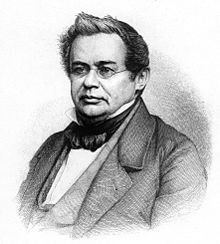Emil Lenz | |
|---|---|
 | |
| Born | (1804-02-12)12 February 1804 Tartu, Governorate of Livonia, Russian Empire |
| Died | 10 February 1865(1865-02-10) (aged 60) Rome, Papal States |
| Alma mater | University of Tartu |
| Known for | Lenz's law Joule–Lenz law |
| Scientific career | |
| Institutions | Saint Petersburg State University |
| Articles about |
| Electromagnetism |
|---|
 |
|
|
Electrostatics
|
|
Magnetostatics
|
|
Electrodynamics
|
|
Electrical network
|
|
Magnetic circuit
|
|
Covariant formulation
|
|
Heinrich Friedrich Emil Lenz (⫽lɛnts⫽; German: [lɛnts]; also Emil Khristianovich Lenz, Russian: Эмилий Христианович Ленц; 12 February 1804 – 10 February 1865), usually cited as Emil Lenz or Heinrich Lenz in some countries, was a Russian physicist of Baltic German descent who is most noted for formulating Lenz's law in electrodynamics in 1834.